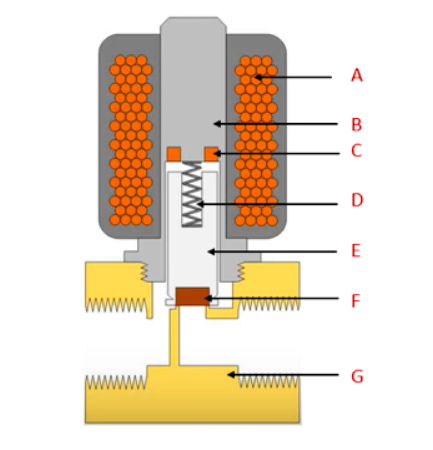
In several domestic, commercial, or industrial settings where gases or liquids have to be distributed or mixed, solenoid valves are used to ensure the accuracy and precision of all the control aspects. To help you understand the types and working principles of solenoid valves, selection criteria, and everything in between, we’ve covered all you need to know about these electrically controlled valves. You should also have a look at the Linear Solenoid.
What are Solenoid Valves and How Do They Work?
Solenoid valves are electromechanical devices that feature two major components: a valve body (G) and a solenoid (Figure 1). The solenoid is an electric coil (A) with a movable magnetic core that’s centrally located, also called a plunger (E). It’s also made up of an armature (B), a shading ring (C), a spring (D), and a seal (F).
For a normally closed valve in the resting position, the plunger closes a small hole or orifice that allows the fluid to flow. As soon as the electric current passes through the coil, it’s energized, and an electromagnetic field forms and exerts a force on the plunger, opening the orifice.
That said, it’s worth noting that solenoid valves are only used to control clean liquid and gases. This is because dirt can easily block the orifice, causing performance issues.

Types of Solenoid Valves
Before we look at the working principles of solenoids, we’ll first look at the two popular solenoid valve configurations. These are the normally closed (NC) and the normally open (NO) solenoid valves.
For NC solenoid valves, it is closed when the coil is de-energized, i.e., when there’s no electric current flowing through it. This means that the orifice is closed, and no medium can flow through it. Once the solenoid is powered, the current flows through the coil and energizes it. This creates an electromagnetic field with a resultant force that pushes the plunger upwards to overcome the resistive spring force. This opens up the orifice and allows the fluid media to flow through the valve. NC valves are good for fail-safe applications that need the media to stop flowing if power is lost.
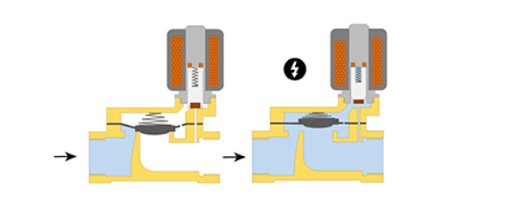
With NO solenoid valves, the valve is always open when the coil is de-energized. Once an electric current passes through the coil, an electromagnetic field is created, and the resultant force pushes the plunger to the downward position to overcome the resistive spring force. Here, the seal will be seated right on the orifice, closing it and preventing any fluid from flowing via the valve. Often, a NO solenoid is best used for applications, which require the solenoid valve to be on or open for a longer period since it becomes more energy and cost-efficient.
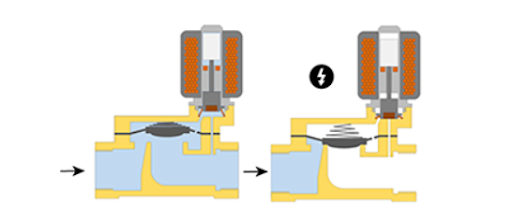
Besides the normally closed and normally open solenoids, there’s also another type called the latching or bi-stable solenoid valve. Unlike the previous two, this type is switched on and off using an instantaneous or momentary power source. The solenoid will stay in its recent/current position provided there’s no power supplied. This is accomplished by replacing a spring with permanent magnets.
Working Principles of Solenoid Valves
There are three main ways in which solenoids work. These are:
Direct-acting
A direct-acting solenoid can either be NO or NC, and its mode of operation is simple. The maximum flow rate and operating pressure are directly proportional to the hole size (diameter) and the solenoid valve’s magnetic force. With this operating principle, the solenoid doesn’t require a minimum pressure or any pressure difference. Direct-acting solenoids are therefore used for small flow rates.
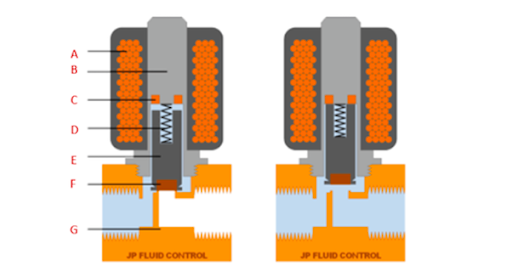
Indirect-acting, Pilot-operated or Servo
Solenoid valves in this category use the pressure difference of the medium to assist in the opening and closing of the valve. The typical minimum pressure required for the valve to operate is nearly 0.5 bar.
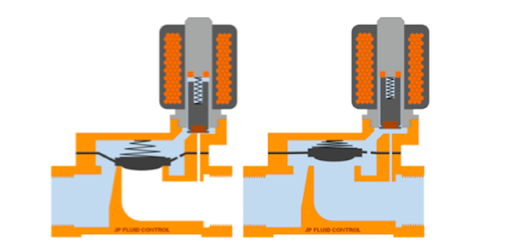
In between the outlet and inlet ports is a rubber layer called a diaphragm, which has an orifice through which the fluid medium can easily flow.
Above the membrane is a pressure chamber that serves as an amplifier. This chamber allows a smaller solenoid valve to control a larger flow rate. They are used in industrial or domestic applications that require a higher flow rate and enough pressure differential.
Semi-direct Acting
With this type of solenoid valve, you enjoy the benefits of both direct-acting and indirect-acting valve operations. Semi-direct acting solenoids operate at zero bar for low flow rate applications and also at pressure differential for high flow rate applications.
Solenoid valves with this working principle have a construction similar to the indirect operating valves except that it has two holes on either side of the membrane, and the plunger is connected directly to the rubber layer. That way, when the electromagnetic force pushes the plunger, the membrane is lifted, opening the valve.
Simultaneously, the second hole is opened if the plunger has a larger diameter compared to the first hole in the rubber membrane. The result is that the pressure inside the chamber above the rubber layer will drop. Hence the membrane isn’t lifted just by the solenoid plunger but also the differential pressure.
Solenoid Valve Use Cases and Approvals
Solenoids are used in industrial, commercial, and domestic applications to close, open, mix or divert fluid medium. Common domestic applications of solenoids include irrigation systems with automatic control and refrigeration systems to control refrigerants.
Other domestic use cases include air conditioning systems to control air pressure, washing machines and dishwashers to control water flow, and water tanks to control the inflow/outflow of water. In commercial settings, solenoid valves find applications in car washes to control soap and water flow.
And since solenoid valves find different applications in various industries, they must have certain approvals to ensure they conform to industry standards and regulations. Some of the common approvals include:
- UL/UR – this is the popular Underwriters Laboratory certification focused on the safety of the solenoid valves.
- Drinking water – there are several approvals that solenoid valves must meet to control water flow used for drinking purposes. Common approvals include the FDA, Kiwa (i.e., a drinking-water approval in the Dutch market), and KTW, which approves plastic and non-metallic consumer materials in Germany.
- CE certification – shows conformity with environmental protection and health requirements for consumer products within the EU economic region.
- ATEX certification – this is an approval for explosion protection.
- IP rating – determines the valve’s protection against dust and water.
Choosing a Solenoid Valve
Now that you know what a solenoid valve is, the types, working principles, use cases, and approvals, what follows is to choose the right type for the right applications. When choosing solenoids, you always want to pay attention to the specific applications and the environment in which they will be installed. From here, you can pay attention to the housing material, the seal material, and the degree of protection as far as temperature and pressure considerations are concerned. Other factors to consider are the operation type, valve function, i.e., whether NO or NC, the voltage type (DC or AC), and the solenoid’s response time.



